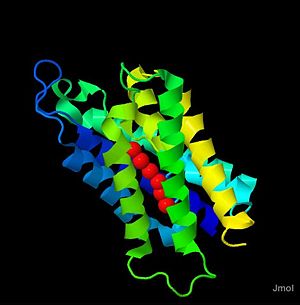User:Daniel Parrell/Sandbox 1
From Proteopedia
Contents |
Aquaporin 4
Background
The discovery of aquaporin channels was a brakthrough discovery relating to water transport in cells. Peter Agre's discovery of the aquaporin channel family, answered a key question that had stumped biochmesists and cell biologists for years. This was the question of how is water abe to transport across the hydrophobic lipid bilayer so efficiently? When experimentally determined, the rate of water transport is able to occure at a rate of about 10^9 molecules per second, this is many times the limit set by diffusion across the membrane. There are 13 known mammalian aquaporins. Each is expressed in different tissues, and serve different functions based of the common theme of water balance. An advantage of this protein redundancy where an organism has different versions of one protein with a similar function in higher animals, is that it allows for specialized expression, and regulation of function to specific tissues. Aquaporins are an example of this phenomenon in mammals and other animals.
Aquaporin 4 (3GD8) is part of the aquaporin family. Majorly expressed in brain astrocytes, it contains the same structural and functional motifs typical of the aquaporin family. Aquaporin 4 (AQP-4) forms a complex in the membrane, composed of four AQP-4 monomers from the membrane bound to produce the tertiary structure. Aquaporin 4 (AQP-4) has been studied heavily in relation to the effects of brain swelling or injury caused by stroke, or trauma, and is largely implied as a regulator of homeostatic levels of water in the brain. Mutatnt mice for the homolouge of human AQP-4 have been developled and studied to gain knowlege on AQP-4 function in the body and the consequences of loss of function. To data the AQP-4 structure has been determined to 1.8 angstrom resolution, and the study of this structure gives helpful insight into the mechanism for water transport by this membrane channel.[1]
|
Structure
Hydrogen Bonding in the Channel
One of the defining features of aquaporins, and of Aquaporin 4 is the center ,its amino acids, and how it interacts, through hydrogen bonding,to drive water transport. The water molecules are held in the channel by the carboxyl oxygens of the amino acid Gly-93, Gly-94, His-95, and Ile-96, Gly-209, Ala-210, Ser-211, and Met-212. The spcific orientation of water in the channel is thought to be driven by a conserved sequence of amino acids called the (Asp-Pro-Ala) that is thought to hold the center water molecules in a specific orientation in the channel which defines the orientation of the other water molecules.
Water Selectivity
The aquaporins as a family are very selective for water, and not other solutes. In fact, most are completely specific for water, and only a few members of the family allow other solutes such as glycerol or urea to move through the channel.[1] The water selectivity of the channel is determined on the extracellular side by what is refered to as a "molecular filter". The channel on the extracellular side is selective for water by reducing the channel diameter to a size that is selective to water molecules. This molecular filter is produced by the amino acids Arg-216 and His-201, and effectiviely blocks the transport of other molecules.[1]
References
- ↑ 1.0 1.1 1.2 Ho, J., Yeh, R., Sandstrom, A., Chorny, I., Harries, W., Robbins, R., Miercke, L. and Stroud, R. 2009 Crystal structure of human aquaporin 4 at 1.8 A and its mechanism of conductance Proceding of the national academy of sciences 106.18:7437-7442.
Citations
1. Tani, K., Mitsima, T., Hiroaki, Y., Kamegawa, A., Nishikawa, K., Tanimura, Y., and Fujiyoshi, Y. 2009. Mechanism of Aquaporin-4's Fast and Highly Selective Water Conduction and Proton Exclusion. Journal of molecular and biochemistry 389:694-706
2. Pasantes-Morales, H. and Cruz-Rangel S. 2010. Brain volume regulation: osmolytes and aquaporin perspectives. Neuroscience 168:87-884.
3. Papadopoulos, M., and Verkman, A. 2007. Aquaporin-4 and brain edema. Pediatr Nephrol 22:778-784.
4. Costa, C., Tortosa, R., Rodriguez, A., Ferrer, I., Torres, J., Bassols, A. and Pumarola, M. 2007. Aquaporin 1 and aquaporin 4 overexpression in bovine spongiform encephalopathy in a transgenic murine model and in cattle field cases. Brain Research 11785:96-106.
5. Ishibashi, K., Hara, S. and Kondo, S. 2008. Aquaporin water channels in mamals. Clinical Experimental Nephrology 13.2:107-117.
6.
7. Nelson D., Cox, M. 2008. Aquaporins form hydrophilic transmembrane channels for the passage of water. In Lehninger Principles of Biochemistry, 5th ed. W.H. Freeman and Company. New York , NY. Pg.404-406.

